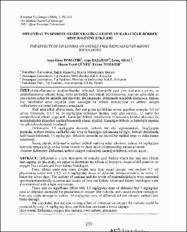| dc.contributor.author | Tomatır, Ayşe Gaye | |
| dc.contributor.author | Başaran, Ayşe | |
| dc.contributor.author | Aral, Erinç | |
| dc.contributor.author | Güneş, Hasan Veysi | |
| dc.contributor.author | Tomatır, Erkan | |
| dc.date.accessioned | 2021-05-05T22:17:02Z | |
| dc.date.available | 2021-05-05T22:17:02Z | |
| dc.date.issued | 2001 | |
| dc.identifier.issn | 1302-4612 | |
| dc.identifier.issn | 2149-7869 | |
| dc.identifier.uri | https://app.trdizin.gov.tr/makale/TVRRMk5qZzQ | |
| dc.identifier.uri | https://hdl.handle.net/20.500.12933/557 | |
| dc.description.abstract | Antienflamatuvar analjeziklerden difunisal, ülkemizde yeni yeni kullanıma girmiş ve antienflamatuvar etkisini hangi yolla gösterdiği tam olarak belirlenmemiş, aspirine göre daha az yan etkilere sahip bir salisilik asit türevidir. Bu çalışmada, diflunisalin terapötik dozlarının, başlıca ilaç metabolize edici organlar olan karaciğer ve böbrek histolojisine ve serbest oksijen radikallerine etkilerini belirlemeyi amaçladık. Kırk adet erkek albino sıçan, dört eşit gruba ayrıldıktan sonra, gruplara sırasıyla; 0,5 ml serum fizyolojik, 3.5,7 ve 14 mg/kg/gün diflunisal dozları, yedi gün süreyle, 12 saatte bir intraperitoneal olarak uygulandı. Karaciğer-böbrek dokularında ve serumda; katalaz aktivitesi ile malondialdehit düzeyleri spektrofotometrik olarak ölçüldü. Karaciğer-böbrek in histolojik yapıları ise ışık mikroskobunda incelendi. Diflunisalin 3.5 mg/kg/gün dozunda, anlamlı bir etki saptanmazken, 7mg/kg/gün dozunda, serbest oksijen radikallerinde artış ve karaciğer dokusunda belirgin, böbrek dokusunda hafif hasar belirlendi. 14 mg/kg/gün difunisal dozunda ise önemli bir radikal artışı ve doku hasarı bulunmadı. Sonuç olarak; difunisal'in serbest radikal inaktive edici etkisinin, sadece 14 mg/kg/gün dozunda ortaya çıktığı ve bu dozun önemli bir doku hasarı oluşturmadığı kanısına varıldı. | en_US |
| dc.description.abstract | Diflunisal is a new derivative of salicylic acid Turkey which has less side effects than aspirin. In this study, we aimed to determine the effects of theraputic doses of diflunisal on on oxygen free radicals and liver-kidney histologies. Forty albino male rats were divided into four equal groups, and recived 0.5 ml physiolocig saline and 3.5,7, or!4 mg/kg//day doses of difunisal intraperitoneally, in every 12 hours for seven days. The activity of catalase and the levels of malondialdehyde were measured spectrophotometrically in serum and tissues of liver and kidney. Liver and kidney histologies were also examined with a light microscope. There was no significant effect with 3.5 mg/kg/day dose of difunisal but 7 mg/kg/day dose of difunisal increased the production of oxygen free radicals, and caused evident damage in liver and slight damage in kidney. 14 mg/kg/day dose of difunisal did not increase radicals and tissue damage. We concluded that the inactivating effect of diflunisal on oxygen fre radicals could be produced by only 14 mg/kg/day dose, and this dose not cause a tissue damage. | en_US |
| dc.language.iso | tur | en_US |
| dc.rights | info:eu-repo/semantics/openAccess | en_US |
| dc.subject | Mikroskopi | en_US |
| dc.subject | Biyokimya ve Moleküler Biyoloji | en_US |
| dc.subject | Hücre Biyolojisi | en_US |
| dc.subject | Tıbbi Araştırmalar Deneysel | en_US |
| dc.subject | Üroloji ve Nefroloji | en_US |
| dc.title | Diflunisal'in serbest oksijen radikallerine ve karaciğer böbrek histolojisine etkileri | en_US |
| dc.title.alternative | The effects of diflunisal on oxygen free radicals liver-kidney histologies | en_US |
| dc.type | other | en_US |
| dc.department | AFSÜ | en_US |
| dc.identifier.volume | 2 | en_US |
| dc.identifier.issue | 3 | en_US |
| dc.identifier.startpage | 233 | en_US |
| dc.identifier.endpage | 242 | en_US |
| dc.relation.journal | Kocatepe Tıp Dergisi | en_US |
| dc.relation.publicationcategory | Makale - Ulusal Hakemli Dergi - Başka Kurum Yazarı | en_US |
















